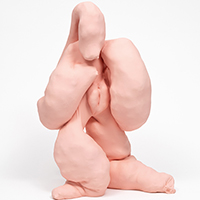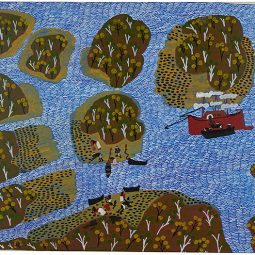“. . . ‘awakening’ signalled a wider emergence, and new beginnings.”
“We discussed the exhibition title with the curatorium,” curatorium member and MUMA Director Dr Rebecca Coates tells me about Awakening Histories. “Our former MUMA colleague Pierra van Sparkes (Pibbulman Noongar) suggested we consider the teachings and writings of Dr Vicki Couzens, a Gunditjmara woman from the Western Districts of Victoria. Vicki had used the word ‘sleeping’ as a means of reclaiming and reinvigorating cultural knowledges and practices.”
Coates adds: “When we shared this with the wider curatorium, they wanted to build on this legacy through a project that brought First Nations and Indonesian artists together. If ‘sleeping’ reclaimed and reinvigorated cultural knowledge and practices, ‘awakening’ signalled a wider emergence, and new beginnings.”
Informed by some of the research learnings from Monash University’s ARC Laureate project ‘Global Encounters & First Nations Peoples: 1000 Years of Australian History’ – with Project Lead for the ARC, Professor Lynette Russell, being one of the curatorium –, for Awakening Histories, Coates explains: “We chose to focus specifically on one area of the research, around the trade and exchanges between Makassan traders and First Nations peoples across the top end of this continent, now known as Australia, from the Gulf of Carpentaria around Arnhem Land to Garamilla/Darwin – an area known as Marege to the sailors from Makassar – and beyond to the Kimberley region, or Kaya Djawa.”

Mr N Wunuŋmurra, Waŋupini, 2017
Art Gallery of New South Wales, purchased with funds provided by the Aboriginal Art Collection Benefactors 2018
© Estate of Nawurapu Wunurimurra / Image © Art Gallery of New South Wales
While there have been other exhibitions developed around the trepang and the Makassan trade, Coates says: “our unique university context makes the way we work with artists and approach these ideas different.” Works from twenty-seven artists and collectives are presented, sharing stories of migration, trade and cultural exchange, and alongside new commissions are significant borrowed works from leading state and national institutions.
Many new ideas are introduced through the works, Coates tells me, and while some may be speculative, others are based on research and fact. As to shared stories explored, Coates says some “highlight the roles of trepang or sea cucumber, tamarind trees, palm wine, seafaring technology, metal tools, textiles and patterns and ceremony and song in histories shared across the ocean.”

Nancy McDinny, Macassin Collecting Trapang, c.2006
© Nancy McDinny/Copyright Agency, 2025 Australian National Maritime Museum Collection
A new commission is by Abdul-Rahman Abdullah, who draws on his maternal lineage back to the old Luwu Kingdom in South Sulawesi. “His Bugis ancestors were expelled in 1664 and, through Borneo, Cambodia and peninsular Malaysia, they descend to him, living on Binjerup Nyungar Country in the south-west of Western Australia,” Coates says. “This series of drawings, Finding Bilqis, Merentasi, Reflections and Kerbau, 2025, offers a reimagining of his children within the worlds of their different ancestries.”
Another new commission is Category of Significance: Ancestral (Tamarindus indica), 2025, by Larrakia artist Jenna Lee, which brings together fifteen glass tamarind seeds, each sprouting saplings cut from the pages of Aboriginal Words and Place Names. “The number gestures to the fifteen tamarind trees recorded on the Larrakia region’s Register of Significant Trees,” Coates says, “among them a burial tree at Mindil Beach (Mindil, meaning ‘the shoulder of an ancestor’ in Gulumoerrgin/Larrakia language), now standing beside the bustle of a popular tourist night market.”

Ipeh Nur, The Body and Journey, 2019–22
Photograph: Silversalt
Courtesy the artist and ara contemporary, Jakarta
In exploring the deep connections between the First Nations Peoples of Northern Australia and the Makassan seafarers of South Sulawesi, Indonesia, Coates says Awakening Histories reveals a powerful truth. “These stories of exchange and connection directly challenge the myth that at the time of British invasion, Australia was terra nullius or land belonging to no one,” Coates says. “This doctrine did not acknowledge the sovereignty of First Nations peoples, their occupation of and intimate connection with the continent and surrounding islands for millennia.”
Dr Joseph Brennan is a Lambda Literary Award-nominated author based in Tropical North Queensland.
Monash University Museum of Art
4 October to 6 December 2025
Melbourne


